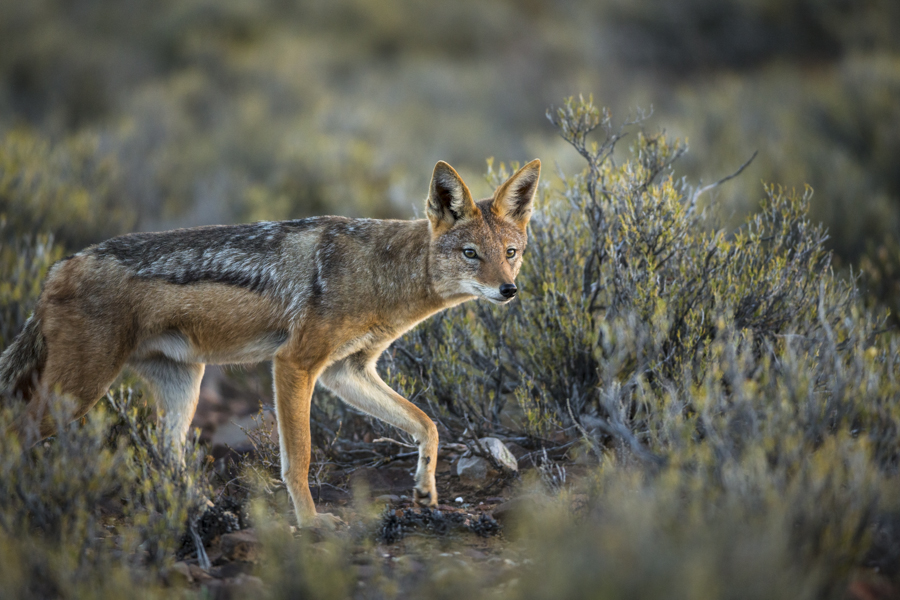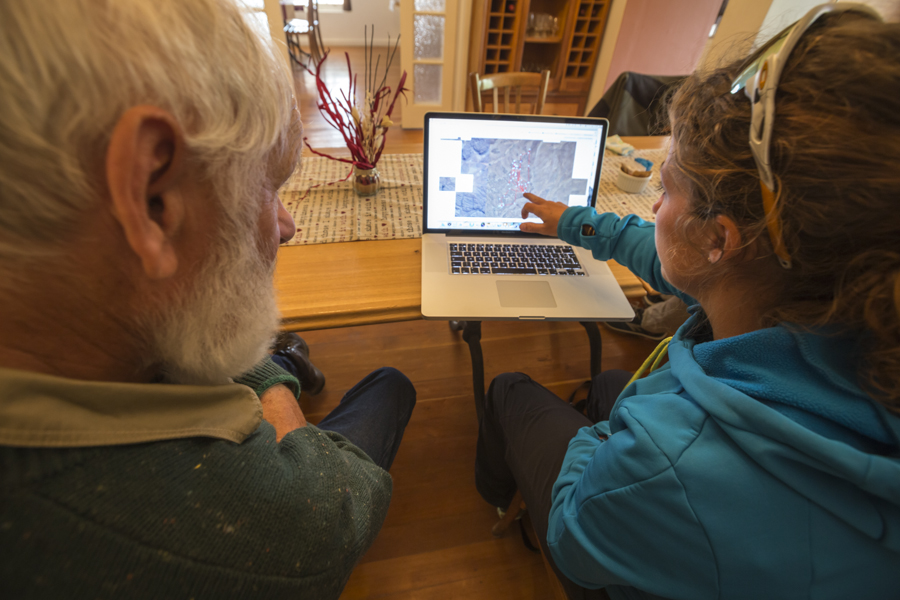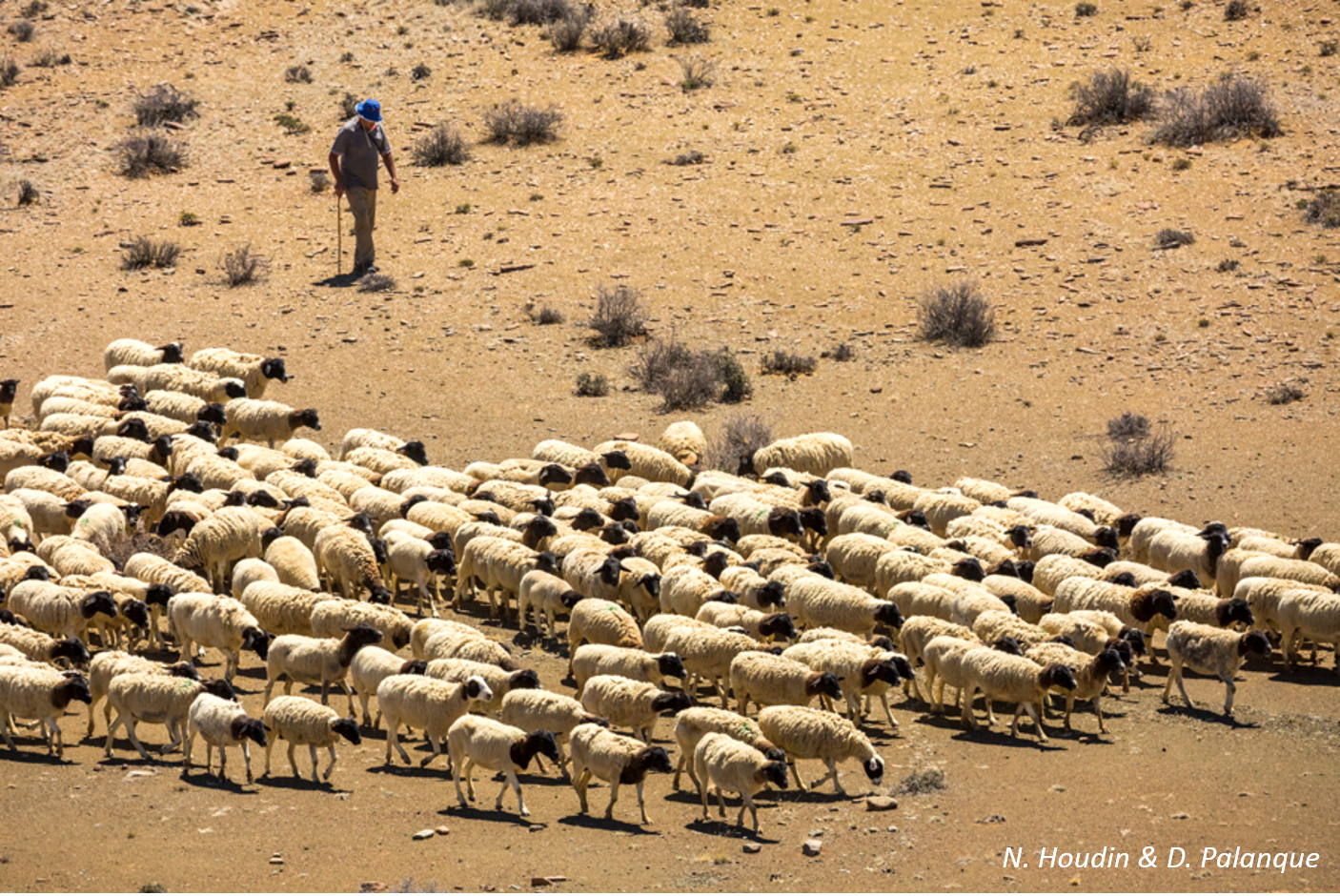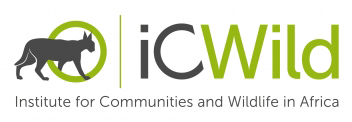|
Jump to: iCWild's work · Key insights · Project team · Collaborators and funders · Outputs |
With the abundance and concentration of food sources (in the form of sheep), small-livestock farms directly affect the ranging patterns and behaviour of predators. They also impact wildlife species richness and relative abundance. In the Karoo region of South Africa, farmers have responded to the threat of livestock predation through sustained hunting programs and live trapping of predators, mainly of black-backed jackal, caracal and chacma baboons.
iCWild's work

In 2013, PhD Candidate Marine Drouilly began the Karoo Predator Project in order to understand the characteristics, determinants and management of farmer-predator conflict. To do so, she used methods from the fields of biology and humanities. She deployed more than 160 camera traps on farmland and a nearby protected area; she used the latter as a baseline. Marine also fitted black-backed jackals and caracals with GPS collars and collect their scats in both land use types to study their diet, prey preferences, and dietary niche relationships. To better understand farmers’ interactions with these mesocarnivores, Marine also conducted face-to-face interviews and recorded data on (1) farmer perceptions and attitudes towards various predator species, and (2) farmer knowledge, experience and management strategies to limit predation on their livestock.
As the project developed, small-livestock farmers were increasingly reporting high levels of lamb predations by baboons, especially during droughts. So, in 2015, through the work of Dr Marion Tafani, we expanded the focus of the project to include research on baboon ecology and to better understand the rising conflict. Marion used the results of the interviews led by Marine to understand the conflict between baboons and small-livestock farmers in terms of perception, localisation and level of threat for the viability of the farms. She also performed isotope analysis of baboon hair samples to investigate the contribution of meat, notably livestock, to their diet. Finally, she explored how baboon moved through and selected habitats within this landscape.
Key insights

Predators leaving protected areas do not seem to prey on sheep.
Through the analysis of prey remains found in predator scats collected on farmland and a nearby protected area, we found that caracals prefer to eat wild prey in both land use types. Black-backed jackals showed the same preference in protected areas, although they selectively ate small-livestock rather than similar-sized wild prey on farmlands. These results suggest that there is no evidence for the belief amongst local farmers that these predators leave the protected area to prey on sheep on farmland. They also suggest that reducing predation will require that farmers use husbandry techniques to decrease the availability of their livestock to jackals.
Private landowners are important custodians of indigenous wildlife.
Our extensive camera trap surveys revealed that rangeland used for small-livestock farming in the South African Karoo supports a diverse community of terrestrial vertebrates, with the exception of large carnivores. Private landowners are thus important custodians of indigenous wildlife, and the extensive small-livestock farms in low-lying areas represent an important opportunity for biodiversity conservation outside of formal protected areas. However, large carnivores require protected areas to be able to survive in the Karoo.

Farms experience different levels of predation, but all farmers perceive predation to be on the increase.
Through interviews with small-livestock farmers in the Karoo, we showed that jackal predation seems to have re-emerged in the region, particularly since the 2000s, while baboon predation seems to have escalated rapidly since 2014 for certain farmers. Farmers perceive predator numbers to be increasing and attribute this trend to declining government support for predator management, changes in farming practices, and the associated increase in suitable predator habitat (from which the predators can recolonise farmland). Farms with more rugged terrain are also more likely to experience serious problems with baboons and caracals.
Lethal control of mesopredators can be counter-productive.
Irrespective of measurement approach, lethal control of mesopredators in this fragmented socio-economic landscape was associated with increased livestock losses the following year. Terrain ruggedness and the number of permanent workers on farms were also significant predictors of livestock losses. Our study provides further evidence that lethal control of mesopredators can be counter-productive and supports calls to develop, share, and financially support a range of non-lethal methods to protect livestock from expanding predator populations, especially in places where natural recolonisation is occurring.
Despite perceptions of predation, baboons eat mostly vegetarian diets.
Through the isotope analyses of baboon hair samples, we found that most baboons showed a seasonal isotopic signal, mostly coming from plant parts. However, few adult males showed a signal that may reflect some level of carnivory, from insect or livestock feeding.
|
Marine Drouilly (iCWild), PhD candidate and project contact Storme Viljoen (iCWild), MSc graduate Dr Marion Tafani (iCWild), postdoctoral researcher Prof Justin O’Riain (iCWild), supervisor Prof Nicoli Nattrass (iCWild), supervisor Prof Allan Clark (Centre for Statistics in Ecology, Environment and Conservation), co-supervisor A/Prof Beatrice Conradie (Sustainable Societies Unit), collaborator Kai Fitchen (Sustainable Societies Unit), field research assistant |
Collaborators and funders
Related outputs
Click here to view iCWild's full output list, and use the filter tool to view outputs related to the Karoo Predator project.
Photo credits: N. Houdin & D. Palanque




